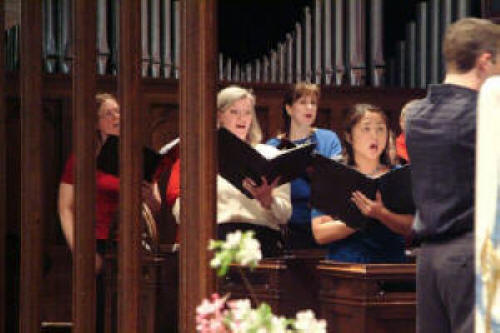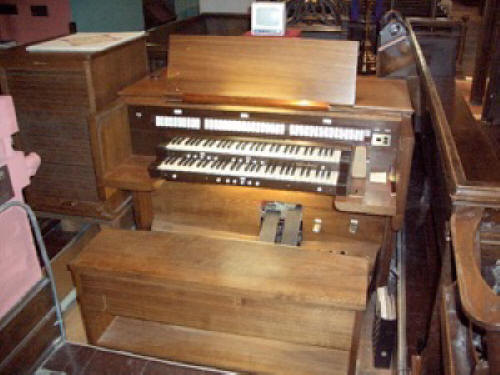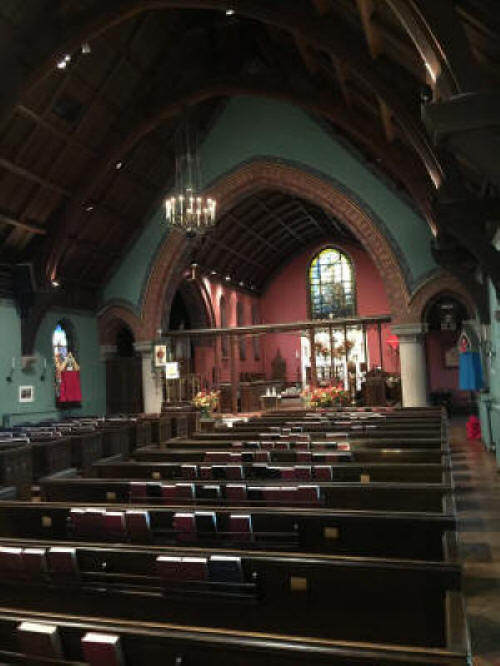|
Builder: Aeolian-Skinner, Opus 1426 (1964) Manuals: 2 Ranks: 27 Stops: 26 Action: Electro-pneumatic Notes: When installed the console faced across the chancel toward the pipes. Today it faces the congregation. -- Nameboard (stop tabs) and combination action have been replaced (between 1966 and 2006) by Gould & Schultz, as has the swell motor (2016). -- Tuba was added by Steve Lethert (1982-83) with pipes from Trivo. -- Reservoirs were re-leathered by Barry Lund, with dates marked on each. -- Great is right behind the arch, with the large swell behind it. Pedal 16' Contrabass is on the left wall of the chamber. -- In 2020 the blower, installed in a box under the Swell, was moved into the basement room below the organ. --Information Nils Halker, David Engen GREAT ORGAN 8 Principal 61 8 Gedecktpommer 61 8 Flauto Dolce SW 4 Octave 61 4 Quintade 61 2 Blockflöte 61 IV Fourniture 244 8 Tuba SW Swell Reeds on Great Great to Great 16 Great Unison Off Great to Great 4 SWELL ORGAN 8 Rohrflute 68 8 Viola Pomposa 68 8 Viola Céleste 68 8 Flauto Dolce 68 4 Prestant 68 4 Koppelflute 68 2 2/3 Quint 61 2 Lieblich Principal 61 IV Scharff 244 16 Fagotto 68 8 Trompette 68 4 Rohrschalmei 68 8 Tuba 61 Tremulant Swell to Swell 16 Swell Unison Off Swell to Swell 4 PEDAL ORGAN 16 Contra Bass 32 16 Rohrbourdon 12 8 Principal 12 8 Rohrflute SW 4 Choralbass 12 8 Tuba SW Swell Reeds on Pedal Great to Pedal 8 Swell to Pedal 8 Swell to Pedal 4 Zimbelstern (1982) "A new two-manual Aeolian-Skinner instrument was installed at St. Clement's Memorial Church, St. Paul, Minn. St. Clement's Church was designed by Cass Gilbert and seats only 250 people. The new organ was designed by Larry King, former organist, and the staff of Aeolian-Skinner. A few suggestions were made by Merrill N. Davis III, who was appointed director of music last July." -- The Diapason 1964 Tuba stops originally activated by push buttons on panel to the right of the manuals. Changed to tabs on the stop rail when solid state was added. New stop tabs were made, stop name changes & pedal stop deletions were made at that time. When they added solid state, whoever did the work replaced all the rocker stop tabs. I guess they couldn't fit "Fourniture" on the new one, so changed it to "Mixture" and the "Rohrbordun" to “Rohrbourdon”. The new tabs are slightly wider, and they had to add three more for the Tuba one each keyboard, so they killed a 4' flute and the rauschquinte (prep) on the pedal to make room on the stop rail. A move away from the more neo-Baroque concept of Larry King. --Charles Hackman |
 |
 |
|
 |
|
 |
|
 |
|
 |